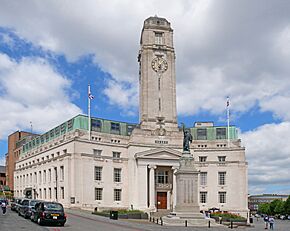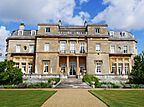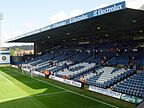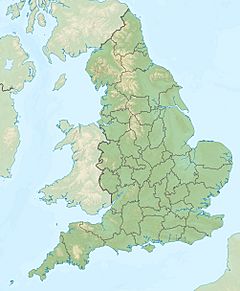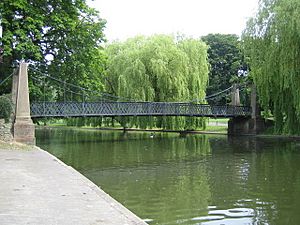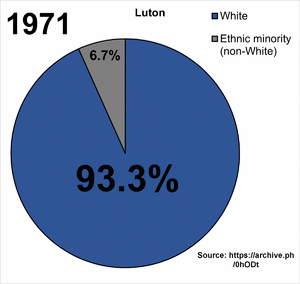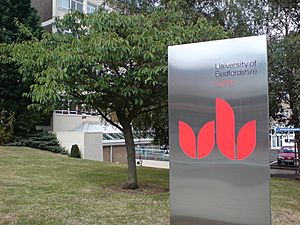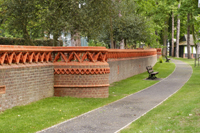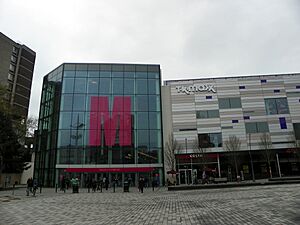Luton facts for kids
Quick facts for kids
Luton
|
|
|---|---|
|
Top to bottom, left to right: Luton Town Hall, Luton Hoo, St Mary's Church, Luton Airport and Luton Town's stadium Kenilworth Road
|
|
| Motto(s): | |

Luton shown within Bedfordshire
|
|
| Sovereign state | United Kingdom |
| Country | England |
| Region | East of England |
| Ceremonial county | Bedfordshire |
| Settlement | c. 6th century |
| Borough | 1876 |
| Administrative HQ | Luton Town Hall |
| Government | |
| • Type | Borough |
| • Body | Luton Borough Council |
| Area | |
| • Total | 16.74 sq mi (43.35 km2) |
| Area rank | 283rd |
| Population
(2005 est.)
|
|
| • Total | 213,052 |
| • Rank | 84th |
| Demonym(s) | Lutonian |
| Ethnicity (2021) | |
| • Ethnic groups |
List
|
| Religion (2021) | |
| • Religion |
List
37.9% Christianity
32.9% Islam 17.6% no religion 11.6% other |
| Time zone | UTC+0 (GMT) |
| • Summer (DST) | UTC+1 (BST) |
| Postcode Area |
LU
|
| Dialling code | 01582 |
| ISO 3166 code | GB-LUT |
| International airport | London Luton Airport (LTN) |
| Railway stations | Luton (B) Luton Airport Parkway (D) Leagrave (D) |
| OS grid reference | TL0896521763 |
| GSS code | E06000032 |
| ONS code | 00KA |
| NUTS 3 | UKH21 |
| FIPS 10-4 | UKI1 |
Luton (![]() i/ˈluːtən/) is a town and borough in Bedfordshire, England. In 2021, about 225,262 people lived there.
i/ˈluːtən/) is a town and borough in Bedfordshire, England. In 2021, about 225,262 people lived there.
Luton is located on the River Lea, about 32 miles (50 km) north-west of London. The town started in the sixth century as a Saxon settlement. Its name comes from the river. Luton is mentioned in the Domesday Book as Loitone and Lintone. St Mary's Church, one of the biggest churches in Bedfordshire, was built in the 12th century. You can learn about Luton's history at local museums like Wardown Park and Stockwood Park.
Luton was famous for hatmaking and also had a big Vauxhall Motors car factory. Cars were made there from 1905 until 2002. They still make commercial vehicles there. The main office for Vauxhall Motors is in Chalton, near Luton. London Luton Airport opened in 1938 and is now a major airport in Britain. Luton also has three train stations. The University of Bedfordshire has two campuses in Luton. Since 1997, Luton Borough Council has been in charge of all local government services in the area.
Luton Town Football Club is nicknamed the Hatters because of the town's hat-making history. They have played in the top football league in England many times. They also won the Football League Cup in 1988. Their home stadium is Kenilworth Road, which they have used since 1905. Plans for a new, bigger stadium were approved in 2019.
The Luton International Carnival is the biggest one-day carnival in Europe. It happens in late May. The Saint Patrick's festival is held around Saint Patrick's Day. This is because Luton has a large Irish community. There is also a big Pakistani community. Both groups came to Luton for jobs at the Vauxhall car factory. Luton Hoo is a grand English country house with a large estate.
Contents
- History of Luton: A Journey Through Time
- How Luton is Governed
- Luton's Location and Environment
- People of Luton
- Luton's Economy and Jobs
- Getting Around Luton: Transport Links
- Learning and Education in Luton
- Luton's Culture and Fun Activities
- Parks and Outdoor Activities
- Shopping in Luton
- Sports in Luton
- Luton's Twin Towns
- Famous People from Luton
- Freedom of the Borough
- See also
History of Luton: A Journey Through Time
Luton was likely started by the Anglo-Saxons around the 6th century. Its name, Lygetun, first appeared in the 8th century. It means "town on the River Lea".
Early Days: From Domesday to Churches
The Domesday Book from 1086 calls Luton Loitone and Lintone. Back then, farming was the main activity. The town had about 700 to 800 people.
In 1121, Robert, 1st Earl of Gloucester began building St Mary's Church. It was finished by 1137. A castle, which gives its name to Castle Street today, was built in 1139. However, it was taken down by 1154.
Growth and Industry: Hats and Cars
The hat making industry started in the 1600s. It became a very important part of the town's identity.
Luton grew quickly. In 1801, it had 3,095 people. By 1850, it had over 10,000, and by 1901, almost 39,000.
Newspaper printing began in 1854. The first public cemetery opened that same year. Luton officially became a borough in 1876.
The hat trade was biggest in the 1930s. After the Second World War, it declined. Other industries took its place.
In 1907, Vauxhall Motors opened a large car factory in Luton. During the Second World War, this factory built Churchill tanks for the war effort. Because of the factory, Luton was a target for air raids. The town suffered many attacks from the Luftwaffe. 107 people died, and over 1,500 homes were damaged or destroyed.
Challenges and Changes: Town Hall and Airport
The first town hall was destroyed in 1919. This happened during Peace Day celebrations after the First World War. Local people, including many soldiers who had returned from the war, were upset about unemployment. They were also not allowed to use a local park for celebrations. They stormed the town hall and set it on fire. A new town hall was finished in 1936.
Luton Airport opened in 1938. The council owned and ran it. Today, it is one of the biggest employers in the area.
Before the war, Luton's economy was booming. New industries grew, and many new homes were built. Luton also expanded, taking in nearby villages like Leagrave, Limbury, and Stopsley between 1928 and 1933.
After the war, many council housing estates were built. These included areas like Farley Hill, Stopsley, Limbury, Marsh Farm, and Leagrave (Hockwell Ring). The Marsh Farm area was developed in the 1960s to house people moving from London.
The Vauxhall factory partly closed in 2002. This caused job losses and problems for Luton. In 2024, Stellantis, which owns Vauxhall, announced plans to close its operations in Luton.
How Luton is Governed
Luton has one level of local government: Luton Borough Council. Since 1997, it has been a unitary authority. This means it handles all local government tasks. There are no smaller local councils in the borough. Luton is still part of the ceremonial county of Bedfordshire.
Local Representatives
As of the 2024 UK general election, Luton has two Members of Parliament (MPs). They are Sarah Owen for Luton North and Rachel Hopkins for Luton South. Both are from the Labour party.
History of Local Government
Luton used to be an ancient parish divided into five smaller areas. In 1850, the central part of Luton got its first elected local authority, called a local board.
In 1876, Luton became a municipal borough. The new council was given a coat of arms. The wheatsheaf on the crest represents farming and the straw used in hat-making. The bee stands for hard work, and the beehive for the straw plaiting industry. The rose and thistle symbols represent different historical connections to the area.
Over time, some nearby areas like Leagrave, Limbury, and Stopsley became part of Luton. In 1964, Luton became a county borough, meaning it was independent from Bedfordshire County Council. In 1974, it became a non-metropolitan district, which put it back under the county council. But in 1997, it became a unitary authority again, regaining its independence.
Luton's Location and Environment
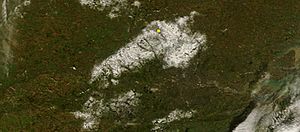
Luton is about 28 miles (50 km) north of London. It is also 39 miles (60 km) southwest of Cambridge. Luton is part of a larger urban area that includes Dunstable and Houghton Regis. It is the biggest town in Bedfordshire.
Natural Features of Luton
Luton is located in a gap in the eastern part of the Chiltern Hills. These hills are made of chalk from the Cretaceous period (about 66 to 145 million years ago). They also have deposits from the last ice age.
Bedfordshire was once known for making bricks, but this industry has greatly reduced. The brickworks in Stopsley used the clay found in the east of town.
The River Lea starts in the Leagrave area of Luton. This river is part of the Thames Valley drainage basin. The Great Bramingham Wood is nearby. It is an ancient woodland, meaning it has been there for at least 400 years.
Because there are few easy routes through the hilly area, several major roads like the M1 and the A6, and a main railway line, pass through Luton.
Luton's Weather Patterns
Luton has a temperate marine climate, similar to much of the British Isles. It usually has light rain throughout the year. The weather can change a lot from day to day. The Gulf Stream makes the region mild for its location. On average, Luton gets 698 mm (27.5 in) of rain each year, with rain falling on 117 days.
Luton's climate is a bit different from other parts of South East England. Because it's in the Chiltern Hills, it tends to be 1–2 degrees Celsius cooler. Sometimes, flights at Luton airport (which is 160 m (525 ft) above sea level) are stopped due to snow. Meanwhile, airports at lower elevations, like Heathrow (25 m (82 ft) above sea level), keep running.
The lowest temperatures recorded near Luton were −17.0 °C (1.4 °F) in December 1981 and −16.7 °C (1.9 °F) in January 1963. The highest temperatures were 36.6 °C (97.9 °F) in July 2019 and 33.8 °C (92.8 °F) in August 1990 and July 2006. These records are from Rothamsted Research Station, about 5 miles (8 km) south-southeast of Luton.
| Month | Jan | Feb | Mar | Apr | May | Jun | Jul | Aug | Sep | Oct | Nov | Dec | Year |
|---|---|---|---|---|---|---|---|---|---|---|---|---|---|
| Record high °C (°F) | 14.2 (57.6) |
18.2 (64.8) |
22.3 (72.1) |
26.8 (80.2) |
27.7 (81.9) |
33.0 (91.4) |
36.6 (97.9) |
35.6 (96.1) |
31.0 (87.8) |
26.8 (80.2) |
17.3 (63.1) |
15.3 (59.5) |
36.6 (97.9) |
| Mean daily maximum °C (°F) | 7.1 (44.8) |
7.6 (45.7) |
10.3 (50.5) |
13.4 (56.1) |
16.6 (61.9) |
19.6 (67.3) |
22.1 (71.8) |
21.7 (71.1) |
18.6 (65.5) |
14.3 (57.7) |
10.1 (50.2) |
7.4 (45.3) |
14.1 (57.4) |
| Daily mean °C (°F) | 4.3 (39.7) |
4.6 (40.3) |
6.6 (43.9) |
9.0 (48.2) |
11.9 (53.4) |
14.9 (58.8) |
17.2 (63.0) |
17.0 (62.6) |
14.4 (57.9) |
10.9 (51.6) |
7.2 (45.0) |
4.7 (40.5) |
10.2 (50.4) |
| Mean daily minimum °C (°F) | 1.6 (34.9) |
1.5 (34.7) |
2.8 (37.0) |
4.5 (40.1) |
7.3 (45.1) |
10.2 (50.4) |
12.3 (54.1) |
12.3 (54.1) |
10.1 (50.2) |
7.5 (45.5) |
4.2 (39.6) |
2.0 (35.6) |
6.4 (43.5) |
| Record low °C (°F) | −16.7 (1.9) |
−13.6 (7.5) |
−12.2 (10.0) |
−6.2 (20.8) |
−2.8 (27.0) |
0.0 (32.0) |
2.8 (37.0) |
3.1 (37.6) |
−0.6 (30.9) |
−4.7 (23.5) |
−7.5 (18.5) |
−17.0 (1.4) |
−17.0 (1.4) |
| Average precipitation mm (inches) | 67.6 (2.66) |
50.9 (2.00) |
42.7 (1.68) |
51.2 (2.02) |
51.2 (2.02) |
52.9 (2.08) |
52.2 (2.06) |
68.2 (2.69) |
55.4 (2.18) |
78.2 (3.08) |
76.8 (3.02) |
67.2 (2.65) |
714.5 (28.13) |
| Average precipitation days (≥ 1.0 mm) | 12.2 | 10.4 | 9.2 | 9.5 | 8.4 | 8.3 | 8.5 | 9.5 | 8.9 | 11.4 | 12.1 | 11.8 | 120.2 |
| Mean monthly sunshine hours | 60.0 | 78.3 | 119.1 | 165.9 | 202.5 | 205.2 | 209.0 | 194.4 | 149.8 | 111.5 | 69.2 | 56.0 | 1,620.9 |
| Source 1: Met Office | |||||||||||||
| Source 2: KNMI | |||||||||||||
People of Luton
The 2021 United Kingdom census showed that Luton had a population of 225,262 people. This was a 10.9% increase from 2011. In 2021, 23% of residents were under 16, 65% were aged 16 to 64, and 12% were 65 or older.
People who live in Luton are called Lutonians.
Diversity in Luton
Luton has welcomed many people from other countries over the years. In the early 1900s, people from Ireland and Scotland moved to the town. Later, immigrants from South Asia and the Caribbean arrived. More recently, people from European countries like Albania have made Luton their home.
Because of this, Luton has a very diverse population. A large number of people are of Asian descent, mainly Pakistani (18.3%) and Bangladeshi (9.2%). In 2021, 86% of Luton's Muslim population were from Asian ethnic groups.
In 2021, less than a third of Luton's population (31.8%) identified as White British. Overall, 45.2% of Luton's population in 2021 was White (including non-British White people). This was down from 54.7% in 2011.
Religious Beliefs in Luton
At the 2021 census, here's how people in Luton identified their religion:
| Religion | Population | % |
|---|---|---|
| Christian | 85,297 | 37.9 |
| Muslim | 74,191 | 32.9 |
| Hindu | 7,438 | 3.3 |
| Sikh | 3,032 | 1.3 |
| Buddhist | 664 | 0.3 |
| Jewish | 246 | 0.1 |
| Other religion | 1,115 | 0.5 |
| No religion | 39,580 | 17.6 |
| Religion not stated | 13,697 | 6.1 |

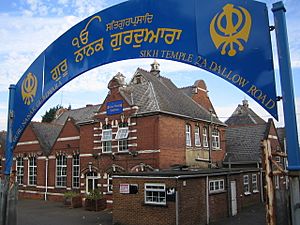

Luton's Economy and Jobs
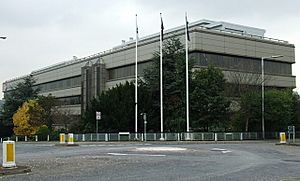

Luton's economy used to focus on industries like car manufacturing, engineering, and hat-making. Today, it's shifting towards service industries, especially retail and the airport. However, light industry is still important.
Major Companies in Luton
Some well-known companies have their main offices in Luton:
- EasyJet – Their main office and base are at London Luton Airport.
- Impellam Group – Their headquarters are at Capability Green.
- TUI UK (TUI Airways) – A travel company located at Wigmore House.
- Vauxhall Motors – Their headquarters are at Chalton House.
Other big companies with offices in Luton include:
- Anritsu – Electronics
- AstraZeneca – Medicines
- Selex ES – Aerospace
- Ernst & Young – Accountants
- Whitbread – Hospitality (hotels and restaurants)
- Stonegate Pub Company – Hospitality
Luton has seen a decline in its traditional industries, similar to some towns in northern England.
Jobs in Luton
About 63% of Luton's working-age population (16–74 years old) have jobs. This includes students, self-employed people, and those working part-time. About 11% are retired, 8% take care of their family or home, and 5% are unemployed.
Getting Around Luton: Transport Links
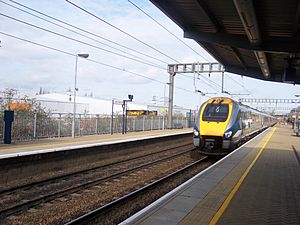
Luton is less than 30 miles (50 km) north of central London. This means it has good connections to London and other parts of the country. Major roads like the M1 (at junctions 10 and 11) and the A6 serve the town.
Train and Air Travel
The town has three train stations: Luton, Leagrave, and Luton Airport Parkway. These stations are served by East Midlands Railway and Thameslink trains.
Luton is also home to London Luton Airport. This is one of the main airports for London and the south-east of England. A new light metro system, the Luton DART, opened in 2023. It connects the airport to Luton Airport Parkway railway station.
Bus Services
A network of bus services runs throughout the urban area of Luton and Dunstable. These services are run by companies like Arriva Shires & Essex, Grant Palmer, and Centrebus.
A special bus route, called the Luton to Dunstable Busway, opened in 2013. It connects Luton with the airport, Dunstable, and Houghton Regis. Another bus company, Uno, also runs buses from Luton to Hatfield, Potters Bar, and Cockfosters.
Luton Borough Council is in charge of local roads, public transport, and taxi licensing in the area.
Learning and Education in Luton
Luton is one of the main locations for the University of Bedfordshire. A large part of the university is in Luton town centre. There's also a smaller campus at Putteridge Bury, an old Victorian manor house. The university also has campuses in Bedford, Milton Keynes, and Aylesbury.
The town has Luton Sixth Form College and Barnfield College. Both have been recognized for their excellent learning and skills programs.
Luton's schools and colleges were set to receive major funding from a government program called Building Schools for the Future. This program aimed to update and refit school buildings across the country. Luton was in the third group for this program, with work planned to start in 2009. However, the program was later stopped by the government. Some schools were rebuilt before it ended.
Luton has 98 educational places. These include seven nurseries, 56 primary schools, 13 secondary schools, four further education colleges, and four other learning centers.
Luton's Culture and Fun Activities
Buildings and History
Luton has 92 listed buildings. These are buildings that are important for their history or architecture.
Fun Things to Do in Luton
Luton International Carnival: A Big Party
The Luton International Carnival is the biggest one-day carnival in Europe. It usually happens on the late May Bank Holiday. Up to 150,000 people come to watch it.
The parade starts at Wardown Park. It goes down New Bedford Road, through the town centre, and then back to Wardown Park. There are music stages and food stalls around the town centre and in Wardown Park.
Luton is home to the UK Centre for Carnival Arts (UKCCA). This is the first building in the country made just for carnival arts.
Luton St Patrick's Festival: Celebrating Irish Culture
This festival celebrates St Patrick, the patron saint of Ireland. It is organized by the Luton Irish Forum. It happens on the weekend closest to March 17. The festival includes a parade, market stalls, music, and other Irish-themed events.
Luton Mela: A Taste of South Asia
The first Luton Melā was held in August 2000. It has become one of the most important and popular South Asian cultural events in the eastern region of England.
Luton's Bid for City of Culture
Luton Council wants to become a "City of Culture". This means they want to show off Luton's arts, culture, and creative industries. As part of this plan, they had a pilot year in 2019 with the theme "Peace Riots".
Theatre and Shows
Luton has the Library Theatre, which has 238 seats. It is on the 3rd floor of the town's Central Library. The theatre hosts local amateur drama groups, pantomimes, children's shows, and touring theatre companies.
Luton is also home to The Hat Factory. As its name suggests, this arts center used to be a real hat factory. It opened in 2003 and is now a main place for modern theatre, dance, and music in the area. It offers live music, club nights, theatre, dance, films, activities for children, workshops, classes, and art exhibitions.
News and Radio
Newspapers
The Luton News is now available online as Luton Today.
Radio Stations
- BBC Three Counties Radio is a local BBC station. It broadcasts from Dunstable to Bedfordshire, Hertfordshire, and Buckinghamshire.
- Diverse FM started broadcasting in April 2007.
- Radio LaB (formerly Luton FM) is the university's radio station. It started broadcasting full-time in 2010.
Television
Luton receives TV signals from London and East Anglia. These include BBC and ITV channels.
Places to Visit in Luton

- Dunstable Downs
- Leagrave Park
- Leighton Buzzard Light Railway
- The Hat Factory
- Luton Hoo
- Someries Castle
- Stockwood Discovery Centre
- Stockwood Park
- Wardown Park
- Wardown Park Museum
- Waulud's Bank
- Whipsnade Tree Cathedral
- Whipsnade Zoo
- Woburn Safari Park
- Woodside Farm and Wildfowl Park
- Wrest Park
Parks and Outdoor Activities
Luton has many parks. These include large district parks, smaller neighborhood parks, and local open spaces.
Brantwood Park
In the 1880s, Brantwood Park was an open field. The Town Council bought it in 1894 for recreation. It was one of Luton's first recreation grounds.
Kidney Wood
Kidney Wood is an ancient semi-natural woodland on the southern edge of Luton. It is a County Wildlife Site. Luton Borough Council bought the wood as a public open space. They work to protect its natural features while allowing people to visit for recreation and play. Kidney Wood has a nature trail and play areas.
Memorial Park
Sir Julius Wernher bought the Luton Hoo Estate and the Manor of Luton around 1903. He made many improvements to the manor and its grounds. After his death in 1912, the estate went to Lady Ludlow. Lady Ludlow gave the park to the people of Luton on June 12, 1920. She did this to remember her son, Alex Piggott Werner, who died in the First World War. The park is officially called Luton Hoo Memorial Park.
Stockwood Park: Nature and History

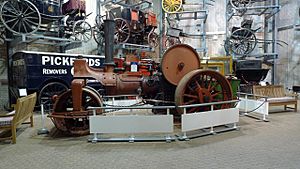
Stockwood Park is a large park near Junction 10 of the M1. Inside the park is Stockwood Discovery Centre. This is a free museum that shows Luton's local history, archaeology, and geology. The museum has a collection of old rural tools and crafts. This collection was put together by Thomas Wyatt Bagshawe, a local historian.
The park also has an athletics track, an 18-hole golf course, and pitches for rugby and football. Stockwood Park RFC is a local amateur rugby team based here. The park used to be the grounds of Stockwood House, which was taken down in 1964. The museum also has the Mossman Collection of horse-drawn vehicles. This is the largest collection of its kind in the country, with original vehicles from the 18th, 19th, and 20th centuries.
Wardown Park: A Riverside Gem
Wardown Park is located on the River Lea in Luton. The park has sports facilities and beautiful gardens. It is also home to the Wardown Park Museum. The park is between Old Bedford Road and the A6, New Bedford Road. It is also close to the town centre.
The museum is in a large Victorian mansion. Its collection focuses on traditional crafts and industries from Luton and Bedfordshire. This includes lace making and hatmaking. You can see samples of local lace from as early as the 17th century.
Shopping in Luton
The main shopping area in Luton is the Mall Luton. It was built in the 1960s and 1970s. When it was built, many older buildings in the town centre were taken down. This included the Plait Halls, which was an old covered market. Shops in other streets, especially around Cheapside and High Town, have declined since then. George Street, south of the Mall, became a pedestrian-only street in the 1990s.
The shopping centre was updated in 2011 and 2012. A new square was built for events, and new restaurants were added. Inside the main shopping centre, there is a market. It has butchers, fishmongers, fruit and vegetable stalls, hairdressers, tattoo shops, and places to eat. There's also a sewing shop for clothes alterations.
Another important shopping area is Bury Park. Here, you can find shops that serve Luton's diverse ethnic communities.
Sports in Luton
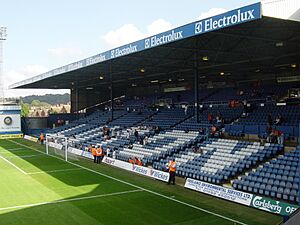
Luton has many sports clubs. It is the home of Luton Town Football Club. In May 2023, they were promoted to the English Premier League for the first time. They have also played in the top English league many times before. They won the League Cup in 1988. Their nickname, 'The Hatters', comes from Luton's hat-making history. Their logo is based on the town's coat of arms. They play at Kenilworth Road, which has been their home since 1905. A new, bigger stadium called Power Court is currently being built.
Bedfordshire County Cricket Club is based at Wardown Park. It is one of the county clubs in English cricket. Luton Rugby Club is a local rugby union club. They are based on Newlands Road, near the M1 motorway and Stockwood Park. They play in London 1 North. Speedway racing used to take place at Luton Stadium from 1934 to 1937.
Luton's Twin Towns
Luton has partnerships with several towns in other countries. These are called town twinnings.
| Country | Place | State/Region | Date | ||
|---|---|---|---|---|---|
| Germany | Bergisch Gladbach | North Rhine-Westphalia | 1956 | ||
| France | Bourgoin-Jallieu | Auvergne-Rhône-Alpes | 1956 | ||
| Sweden | Eskilstuna | Södermanland | 1949 | ||
| Germany | Berlin-Spandau | Berlin | 1959 | ||
| Germany | Wolfsburg | Lower Saxony | 1950 | ||
Famous People from Luton
Here are some people who were born in Luton or have a strong connection to the town.
Born in Luton
- Mick Abrahams, guitarist for Jethro Tull
- Keshi Anderson, footballer
- David Arnold, composer
- Emily Atack, actress
- John Badham, film director
- Lewis Baker, footballer
- Clive Barker, sculptor and artist
- Jonathan Barnbrook, graphic designer and typographer
- Josh Bassett, rugby player
- Kevin Blackwell, goalkeeper and football manager
- Dean Brill, footballer
- William Brown, footballer
- Clive Bunker, drummer for Jethro Tull
- Danny Cannon, screenwriter, director and producer
- Gerald Anthony Coles, artist
- Natasha Collins, actress and television presenter
- Andy Day, television presenter
- Steve Dillon, comic artist
- Kerry Dixon, footballer
- Stacey Dooley, journalist, television presenter and Strictly Come Dancing winner
- Jamal Edwards, entrepreneur, author, director, DJ and founder of SB.TV
- Jonathan Edwards, footballer
- Kevin Foley, footballer
- Sean Gallagher, actor
- Liam George, footballer
- John Hagan, 8th master chief petty officer, US Navy
- Arthur Hailey, novelist
- Nadiya Hussain, The Great British Bake Off winner
- Neil Jackson, actor
- Sharna Jackson, children's writer
- James Justin, footballer
- Stephen Kelman, novelist
- Jamal Lewis, footballer
- Stuart Lewis-Evans, Formula One driver
- Sean Maguire, footballer
- Frederick Mander, General Secretary of the NUT
- Sarfraz Manzoor, journalist and author
- Herbert Moody, footballer
- Monty Panesar, cricketer
- David Price, cricketer
- Phil Read, motorcycle racer
- David Renwick, scriptwriter
- Stu Riddle, footballer
- Lee Ross, actor
- Billy Schwer, boxer
- Andy Selway, drummer
- Junior Simpson, comedian
- Paul Sinha, comedian and quizzer
- Zena Skinner, television chef and author
- Myles Smith, singer
- Steven M Smith, biologist
- Will Smith, cricketer
- David Stoten, storyboard artist
- Jordan Thomas, World and European karate champion
- Mark Titchner, artist
- UK Decay, band
- Richard Wiseman, psychologist
- Jamie Woolford, rock musician for The Stereo, Animal Chin and Let Go
- Paul Young, pop rock singer
- Zuby, rapper
Connected to Luton
- Rodney Bewes, actor
- Mo Chaudry, entrepreneur
- Diana Dors, actress
- Ian Dury, singer
- John Hegley, poet
- Hilda Hewlett, UK's first licensed woman pilot
- Alec Jeffreys, geneticist
- Sarfraz Manzoor, author and columnist, The Guardian
- Eric Morecambe, entertainer
- Elizabeth Price, artist
- Colin Salmon, actor
- Andrew Tate, British-American ex-kickboxer and Internet personality
Freedom of the Borough
The "Freedom of the Borough" is a special honor given to people and military groups in Luton.
Individuals Honored
- John Still: January 15, 2015.
- Bill McKenzie, Baron McKenzie of Luton: January 15, 2015.
- Viv Dunnington: January 15, 2015.
See also
 In Spanish: Luton para niños
In Spanish: Luton para niños


